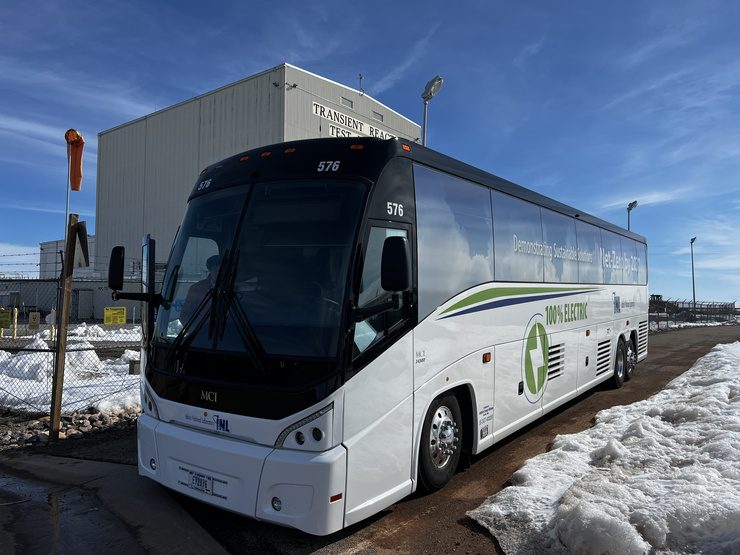Nuclear Power, Electrification, and Carbon-Free Fuel Are Key to INL Achieving Net-Zero by 2031
In 2021, Idaho National Laboratory (INL) Director John Wagner set a lofty goal for the lab to achieve net-zero carbon emissions within 10 years. An uninformed observer might think that would be an easy task for an organization as focused on energy as INL, but it’s important to recognize that the lab is spread over nearly 900 square miles—about three-quarters the size of the state of Rhode Island.
To shuttle the lab’s nearly 5,400 employees everywhere they need to go across that vast territory, INL has a fleet of about 85 motor coaches (Figure 1) with an operating schedule that runs 24 hours a day, seven days a week. With all the transportation and 357 buildings to heat and cool throughout the year, achieving net-zero is a significant challenge.

Jhansi Kandasamy, INL’s net-zero program director, explained that more than half of the lab’s carbon emissions come from purchased electricity. That means INL has to work with Idaho Power to cut much of its emissions. “Probably 60 to 80% is already pretty clean—carbon-free—because they have hydro as a majority electricity generation,” Kandasamy said as a guest on The POWER Podcast, but that still leaves a fairly large gap to fill.
“With my background in nuclear and nuclear being dependable, secure, 24/7, we’ve worked with Idaho Power to say, ‘We’d like to include nuclear as the generation,’ ” Kandasamy said. “If we accomplish that—if we get nuclear—that addresses the 54% of carbon emissions that we get from purchasing electricity. Without doing anything else, we would have reduced our carbon emissions by 70%.”
The Carbon Free Power Project, spearheaded by Utah Associated Municipal Power Systems (UAMPS), with NuScale Power’s VOYGR small modular reactor technology at its heart, seems like a logical fit for Idaho Power’s needs. The six-module plant will be built on INL property and UAMPS is looking for additional subscribers. Kandasamy said INL helped get some of the players, including folks from UAMPS, NuScale, Idaho Power, Idaho Falls Power, and the Department of Energy (DOE), in a room to talk about the project and what needed to be done to ensure it is operational within the next decade. “It’s a collaboration effort instead of competition. It’s all collaboration—getting all the people that are the experts in the room and kind of working through it. And it’s been great in that they’re all coming up with these different ideas,” she said.
In addition to motor coaches, INL also has more than 600 other vehicles in its transportation fleet. Kandasamy suggested there are plans to electrify much of INL’s fleet, as well as adding some hydrogen-fueled vehicles and using carbon-free fuels, such as R99 (renewable diesel), in others, which will all help to cut carbon emissions. Still, getting the vehicles poses a challenge.
INL is required to source its vehicles through the DOE, and the DOE’s supply of electric and hydrogen-fueled models is lacking. “The Executive Order says by 2027 we need to have all of our light-duty vehicles transition to electric. That’s not far away. We have 240 vehicles—light-duty vehicles—that we need to transition. We’ve gotten 24,” Kandasamy said.
Stationary combustion is another big contributor to INL’s carbon emissions. The lab has a large number of diesel generators that are used as backup power sources for test reactors and other critical loads. However, Kandasamy asked managers to take a close look at the loads on each unit, and if a generator wasn’t actually needed for safety reasons, to downgrade its priority and utilize R99 for fuel. The downside with R99 is that engines fueled by it can be unreliable in the winter, but it’s a risk worth taking if the generator is not powering vital equipment.
Yet, employees may be the real key to success. Kandasamy said the staff at INL has really gotten behind the initiative. “The big push is really the cultural shift across the entire laboratory. So, the communication becomes a really huge part of saying, ‘Here’s what we’re doing for each scope. Here’s how each of the employees contributes to getting us to net-zero,’ ” she said.
“We’ve been putting in all these communications about how we’re transitioning. The other part is for the employees to tell their story on how they are achieving net-zero,” said Kandasamy. “That has been huge. Now, it’s like, everybody wants to have their story. So, they start talking about how they are transforming in their personal life, as well as how they’re commuting to work, and so on, with net-zero stories.”
To hear the full interview with Kandasamy, which includes much more about INL’s plans to achieve net-zero by 2031, listen to The POWER Podcast. Click on the SoundCloud player below to listen in your browser now or use the following links to reach the show page on your favorite podcast platform:
For more power podcasts, visit The POWER Podcast archives.
—Aaron Larson is POWER’s executive editor (@AaronL_Power, @POWERmagazine).